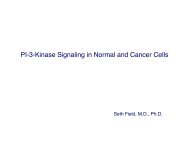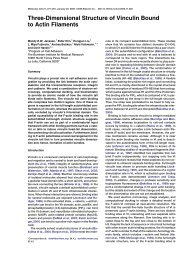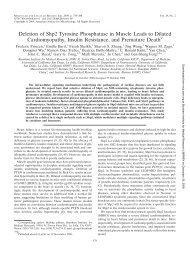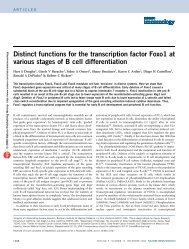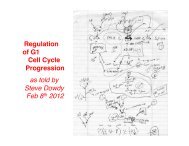Lin lecture.pdf - UCSD/Burnham Molecular Pathology
Lin lecture.pdf - UCSD/Burnham Molecular Pathology
Lin lecture.pdf - UCSD/Burnham Molecular Pathology
Create successful ePaper yourself
Turn your PDF publications into a flip-book with our unique Google optimized e-Paper software.
Endoplasmic Reticulum Stress in<br />
Cancer Pathogenesis<br />
PATH221 <strong>Molecular</strong> <strong>Pathology</strong> of Cancer<br />
Monday, February 4, 2013<br />
Jonathan H. <strong>Lin</strong>, M.D., Ph.D.<br />
Department of <strong>Pathology</strong>
Lecture Outline!<br />
10-10:45 !Endoplasmic Reticulum Function ! !<br />
! !ER Stress & Unfolded Protein Response (UPR)!<br />
! !ER Stress & UPR in Cancer (Chemotherapy)!<br />
11-11:45 !ER Stress & UPR in Cancer!<br />
! ! !(Tumor Immunology)!
Endoplasmic Reticulum Organelle!<br />
From: <strong>Molecular</strong> Biology of the Cell!
Endoplasmic Reticulum Organelle!<br />
Membrane and Secreted Protein Folding and Maturation!<br />
Sterol, Lipid, and Membrane Synthesis & Metabolism!<br />
Calcium Storage!
Protein Folding, Lipid Synthesis, Ca 2+ Stores !
ER Changes Shape According to Need!
ER Changes Size According to Need!
Impairing ER Function Causes ER Stress!<br />
Viral Infections! Protein Aggregates!
Chronic ER Stress is Lethal!<br />
WT P23H<br />
P23H Rhodopsin in Photoreceptor Neurons in Retinitis Pigmentosa!<br />
Diabetes, Neurodegeneration, Viral Infections, Inflammation!
How do cells control the size, shape, and<br />
function of the Endoplasmic Reticulum?!
Cells have developed<br />
intracellular signaling pathways that<br />
monitor demands on the ER and adjust ER<br />
size, shape, and function in response
The Unfolded Protein Response (UPR) !
UPR Signaling Can Protect Cells!
UPR Signaling Can Promote Cell Death!
How does UPR Choose Life vs Death?!<br />
?<br />
Survival Apoptosis
Examine UPR Signaling Over Time!<br />
IRE1!<br />
Xbp-1!<br />
BiP!<br />
PERK!<br />
ATF-4!<br />
CHOP!
IRE1 Signaling is Attenuated with Time!<br />
PERK Signaling Stays On Much Longer!<br />
<strong>Lin</strong> et al., 2007. Science!
UPR signaling pathways have different !<br />
kinetic properties!<br />
Acute! Chronic!<br />
<strong>Lin</strong> et al., 2007. Science!
Chronic ER Stress is Toxic!!<br />
IRE1!<br />
ATF6!<br />
PERK!<br />
PERK!
How does UPR regulate cell fate?!<br />
Create a way to activate IRE1!<br />
Create a way to activate PERK!<br />
Create a way to activate ATF6!<br />
Examine effects of each pathway on!<br />
cell viability!
Selective Chemical Regulators of Kinases!<br />
Traditional chemical<br />
regulators of protein kinases<br />
Regulators generated using a<br />
chemical genetic approach<br />
Kevan Shokat!
Chemical Approach to Control IRE1!<br />
<strong>Lin</strong> et al., 2007. Science!
Control of IRE1 in Transgenic Human Cells!
How does UPR regulate cell fate?!<br />
Create a way to activate IRE1!<br />
Create a way to activate PERK!<br />
Create a way to activate ATF6!<br />
Examine effects of each pathway on!<br />
cell viability!
Chemical Control of PERK!<br />
<strong>Lin</strong> et al., 2009. PLoS ONE!
Control of PERK in Transgenic Human Cells!
Sustained IRE1 promotes cell proliferation!<br />
+mock! +1NM-PP1!<br />
HEK293[I642G]!
Sustained PERK impairs cell proliferation!<br />
+mock! +AP20187!<br />
HEK293[Fv2E-Perk]!
Extended PERK Promotes Apoptosis!<br />
<strong>Lin</strong> et al., 2009. PLoS ONE!
Summary!<br />
• Chemical-genetic approaches to selectively<br />
activate individual signaling pathways independent<br />
of protein misfolding<br />
• IRE1 signaling promotes cell survival<br />
• PERK signaling impairs cell survival<br />
• ATF6 signaling promotes cell survival
How does UPR signal cell death?!
How does UPR Choose Life vs Death?!<br />
?<br />
Homeostasis Apoptosis
Highlights!<br />
• UPR controls cell life and death fates<br />
• New Chemical-Genetic Tools to Control UPR<br />
• IRE1 signaling promotes cell survival<br />
• PERK signaling impairs cell survival
What is the role of ER stress<br />
and UPR in Cancer?!
Endoplasmic Reticulum!<br />
Science Signaling, 29 January 2013<br />
Vol. 6, Issue 260, p. ra7<br />
Vemurafenib Potently Induces Endoplasmic Reticulum Stress–Mediated Apoptosis in BRAFV600E<br />
Melanoma Cells<br />
Daniela Beck1, Heike Niessner1, Keiran S. M. Smalley2, Keith Flaherty3, Kim H. T. Paraiso2, Christian<br />
Busch1, Tobias Sinnberg1, Sophie Vasseur4,5,6,7, Juan Lucio Iovanna4, Stefan Drießen8, Björn Stork8,<br />
Sebastian Wesselborg8, Martin Schaller1, Tilo Biedermann1, Jürgen Bauer1, Konstantinos Lasithiotakis1,<br />
Benjamin Weide1, Jürgen Eberle9, Birgit Schittek1, Dirk Schadendorf10, Claus Garbe1, Dagmar<br />
Kulms11,12, and Friedegund Meier1*<br />
1 Division of Dermatologic Oncology, Department of Dermatology, University of Tübingen, 72076<br />
Tübingen, Germany.<br />
2 Departments of <strong>Molecular</strong> Oncology and Cutaneous Oncology, Moffitt Cancer Center & Research<br />
Institute, Tampa, FL 33612, USA.<br />
3 Massachusetts General Hospital Cancer Center, Boston, MA 02114, USA.<br />
4 Centre de Recherche INSERM, 13288 Marseille, France.<br />
5 Institut Paoli-Calmettes, 13288 Marseille, France.<br />
6 Aix-Marseille University, 13288 Marseille, France.<br />
7 CNRS, UMR7258, CRCM, 13288 Marseille, France.<br />
8 Institute of <strong>Molecular</strong> Medicine, University Hospital Düsseldorf, 40225 Düsseldorf, Germany.<br />
9 Department of Dermatology and Allergy, Skin Cancer Center Charité, Charité–Universitätsmedizin Berlin,<br />
10117 Berlin, Germany.<br />
10 Department of Dermatology, University of Essen, 45122 Essen, Germany.<br />
11 Institute of Cell Biology and Immunology, University of Stuttgart, 70569 Stuttgart, Germany.<br />
12 Experimental Dermatology, Department of Dermatology, TU-Dresden, 01307 Dresden, Germany.
Melanoma!
Melanoma!
Melanoma!
Vemurafenib inhibits BRAF(V600E)!<br />
1. What is the mechanism by which Vemurafenib induces melanoma cell death?<br />
2. Why do melanoma cells acquire resistance to Vemurafenib?
Vemurafenib Induces Apoptosis in BRAFV600E Melanoma Cells
Vemurafenib Triggers ER Stress in BRAFV600E Melanoma Cells<br />
1. Mechanism of<br />
Vemurafenib-<br />
induced melanoma<br />
cell death?<br />
2. Resistance to<br />
Vemurafenib?
ER Stress plays a role in Vemurafenib-induced BRAFV600E<br />
Melanoma cell death
ER Stress triggers BRAFV600E and NRAS melanoma cell death
ER stress inducers overcome acquired resistance to vemurafenib
Summary: ER Stress contributes to Vemurafenib’s mechanism<br />
of melanoma cytotoxicity
UPR in Cancer and Chemotherapy"<br />
1. UPR Signaling Controls Life/Death Cell!<br />
fates in Response to ER stress!<br />
2. Chemotherapeutics Can Act through!<br />
UPR Signaling pathways!<br />
3. Artificial UPR Signaling May Enhance!<br />
Efficacy of Chemotherapeutics!
Lecture Outline!<br />
10-10:45 !Endoplasmic Reticulum Function ! !<br />
! !ER Stress & Unfolded Protein Response (UPR)!<br />
! !ER Stress & UPR in Cancer (Chemotherapy)!<br />
11-11:45 !ER Stress & UPR in Cancer!<br />
! ! !(Tumor Immunology)!
Nobuhiko Hiramatsu, Ph.D.<br />
Jerry Chiang. Ph.D.<br />
Carissa Messah<br />
Heike Kroeger, Ph.D.<br />
National Eye Institute<br />
Fight-For-Sight Foundation<br />
Hope for Vision Foundation<br />
Karl Kirchgessner Foundation<br />
American Federation for Aging Research



